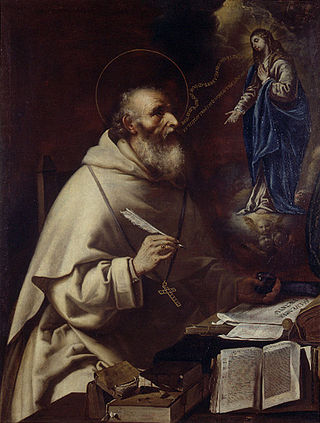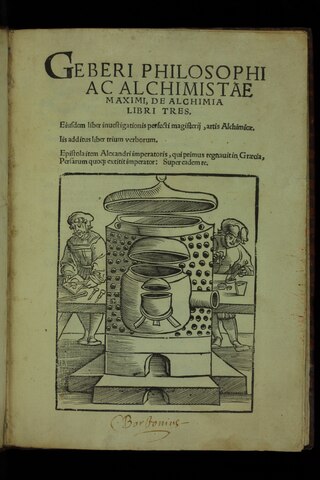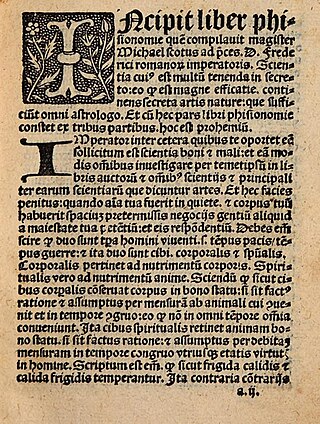Related Research Articles

Alchemy is an ancient branch of natural philosophy, a philosophical and protoscientific tradition that was historically practised in China, India, the Muslim world, and Europe. In its Western form, alchemy is first attested in a number of pseudepigraphical texts written in Greco-Roman Egypt during the first few centuries AD.

Albertus Magnus, also known as Saint Albert the Great, Albert of Swabia or Albert of Cologne, was a German Dominican friar, philosopher, scientist, and bishop, considered one of the greatest medieval philosophers and thinkers.
Bartholomaeus Anglicus, also known as Bartholomew the Englishman and Berthelet, was an early 13th-century Scholastic of Paris, a member of the Franciscan order. He was the author of the compendium De proprietatibus rerum, dated c.1240, an early forerunner of the encyclopedia and a widely cited book in the Middle Ages. Bartholomew also held senior positions within the church and was appointed Bishop of Łuków in what is now Poland, although he was not consecrated to that position.

Vitriol is the general chemical name encompassing a class of chemical compounds comprising sulfates of certain metals – originally, iron or copper. Those mineral substances were distinguished by their color, such as green vitriol for hydrated iron(II) sulfate and blue vitriol for hydrated copper(II) sulfate.

Pseudo-Geber is the presumed author or group of authors responsible for a corpus of pseudepigraphic alchemical writings dating to the late 13th and early 14th centuries. These writings were falsely attributed to Jabir ibn Hayyan, an early alchemist of the Islamic Golden Age.
The Emerald Tablet, the Smaragdine Table, or the Tabula Smaragdina is a compact and cryptic Hermetic text. It was a highly regarded foundational text for many Islamic and European alchemists. Though attributed to the legendary Hellenistic figure Hermes Trismegistus, the text of the Emerald Tablet first appears in a number of early medieval Arabic sources, the oldest of which dates to the late eighth or early ninth century. It was translated into Latin several times in the twelfth and thirteenth centuries. Numerous interpretations and commentaries followed.

The Secretum Secretorum or Secreta Secretorum, also known as the Sirr al-Asrar, is a treatise which purports to be a letter from Aristotle to his student Alexander the Great on an encyclopedic range of topics, including statecraft, ethics, physiognomy, astrology, alchemy, magic, and medicine. The earliest extant editions claim to be based on a 9th-century Arabic translation of a Syriac translation of the lost Greek original. It is a pseudo-Aristotelian work. Modern scholarship finds it likely to have been written in the 10th century in Arabic. Translated into Latin in the mid-12th century, it was influential among European intellectuals during the High Middle Ages.
Frater Albertus Spagyricus born May 5,(1911–1984); founder of the Paracelsus Research Society in Salt Lake City, which later evolved into the Paracelsus College. Based on the Paracelsian concept of three essentials, Body, Soul and Spirit, Frater Albertus developed a system of teaching alchemical concepts using the spagyric technique of separation and cohobation. The unique graduated courses allowed students to explore aspects of the vegetable, mineral and animal kingdoms in an understandable and accessible way. After his death in 1984, the college ceased operations in the United States but continued to carry on the tradition in Australia. Frater Albertus had a profound effect on the way Alchemy and particularly the Spagyric method was disseminated and understood in the mid to late 20th century. His works were translated into many languages. He was a rosicrucian.
Petrus Bonus was a late medieval alchemist. He is best known for his Precious Pearl or Precious New Pearl, an influential alchemical text composed sometime between 1330 and 1339. He was said to have been a physician at Ferrara in Italy, causing him to sometimes be known as Petrus Bonus of Ferrara or as Petrus Bonus the Lombard. An Introduction to the Divine Art is also attributed to him but was printed much later, in 1572.

Theatrum Chemicum is a compendium of early alchemical writings published in six volumes over the course of six decades. The first three volumes were published in 1602, while the final sixth volume was published in its entirety in 1661. Theatrum Chemicum remains the most comprehensive collective work on the subject of alchemy ever published in the Western world.

Petit Albert is an 18th-century grimoire of natural and cabalistic magic. It may have been inspired by the writings of Albertus Parvus Lucius. Brought down to the smallest hamlets in the saddlebags of peddlers, it represents publishing success, despite its association with "devil worshipers"—or rather because of it. It is associated with a second work, the Grand Albert. It is a composite, heterogeneous work, collecting texts written by various authors; most of these authors are anonymous but some are notable such as Cardano and Paracelsus. Due to its historical nature, Albertus Magnus' attribution to the text is considerably uncertain and since the text quotes from many later sources, it is an ethnological document of the first order.

The Liber de causis is a philosophical work composed in Arabic in the 9th century. It was once attributed to Aristotle and became popular in West during the Middle Ages, after it was translated into Latin by Gerard of Cremona between 1167 and 1187. The original title was كتاب الإيضاح لأرسطوطاليس في الخير المحض Kitāb al-Īḍāḥ li-Arisṭūṭālis fī l-khayr al-maḥd, "The book of Aristotle's explanation of the pure good". Its Latin title, Liber de causis, came into use following its translation. The work was also translated into Armenian and Hebrew. Many Latin commentaries on the work are extant.
Bonaventura of Iseo was an Italian Friar Minor, diplomat, theologist and alchemist.

Guglielmo Gratarolo or Grataroli or Guilelmus Gratarolus was an Italian doctor and alchemist.
Philipp Ulstad was a nobleman from Nuremberg, who taught medicine at the academy in Fribourg at the beginning of the sixteenth century.
De Alchemia is an early collection of alchemical writings first published by Johannes Petreius in Nuremberg in 1541. A second edition was published in Frankfurt in 1550 by the printer Cyriacus Jacobus.

Liber physiognomiae is a work by the Scottish mathematician, philosopher, and scholar Michael Scot concerning physiognomy; the work is also the final book of a trilogy known as the Liber introductorius. The Liber physiognomiae itself is divided into three sections, which deal with various concepts like procreation, generation, dream interpretation, and physiognomy proper.

The Grand Albert is a grimoire that has often been attributed to Albertus Magnus. Begun perhaps around 1245, it received its definitive form in Latin around 1493, a French translation in 1500, and its most expansive and well-known French edition in 1703. Its original Latin title, Liber secretorum Alberti Magni de virtutibus herbarum, lapidum et animalium quorumdam, translates to English as "the book of secrets of Albert the Great on the virtues of herbs, stones and certain animals". It is also known under the names of The Secrets of Albert, Secreta Alberti, and Experimenta Alberti.
Secreta mulierum, also known as De secretis mulierum, is a natural philosophical text from the late thirteenth or early fourteenth century frequently attributed to Albertus Magnus, although it is more likely written by one of his followers. Originally written in Latin, the title translates as The Secrets of Women or Of the Secrets of Women. Drawing on Hippocratic, Galenic, and Aristotelian theories, this text discusses sexuality and reproduction from both a medical and philosophical perspective. Over eighty manuscript copies of the treatise have been identified, and it has been translated into multiple different languages over several centuries. This suggests that the ideas expressed in this work were hugely popular and influential. It was added to the Index librorum prohibitorum in 1605.
References
- ↑ Peter Grund (2009), "Textual Alchemy: The Transformation of Pseudo-Albertus Magnus's Semita Recta into the Mirror of Lights", Ambix: The Journal for the Society for the History of Alchemy and Chemistry56(3): 202–225.
- ↑ Adam Gwyndaf Garbutt, Assessing the Exotic: Authority, Reason, and Experience in the Construction of Medieval Natural Knowledge, PhD diss. (University of Toronto, 2018), pp. 147–178.